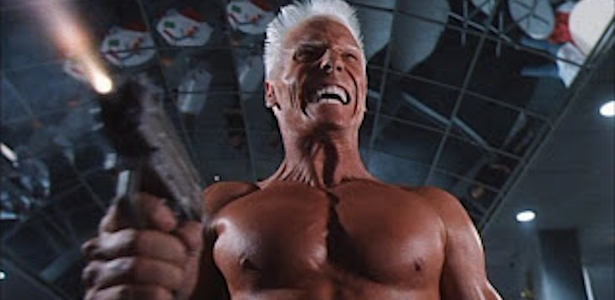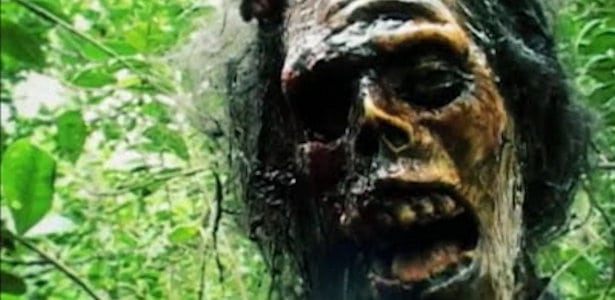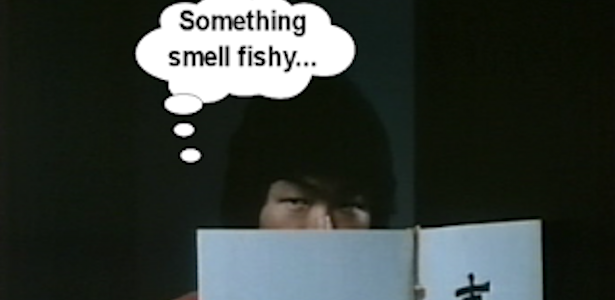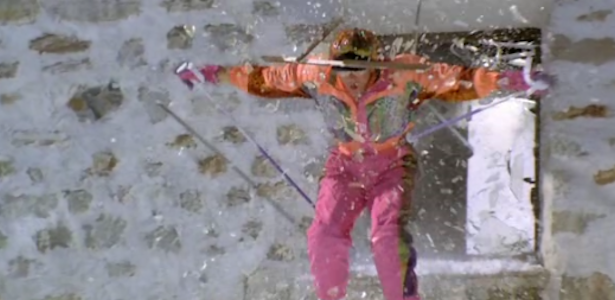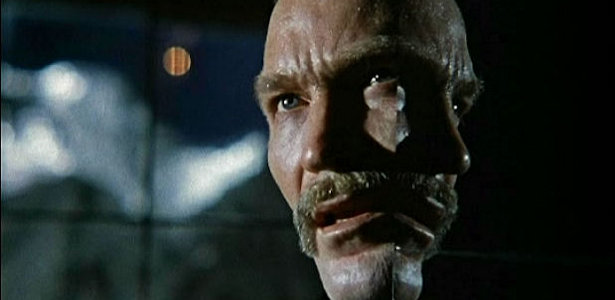With the return of the cult icon Hugh Keays-Byrne to international screens as Immortan Joe in MAD MAX: FURY ROAD (2015), we decided to talk about some of his other film roles. You'd think we'd want to talk about some of the great films he has appeared in over the decades like STONE (1974), MAN FROM HONG KONG (1975), CHAIN REACTION (1980), or BLOOD OF HEROES (1989). That would be too easy when there are films like LES PATTERSON on hand. Quite possibly the biggest Aussie disaster since the 1899 destruction of Bathurst by cyclone Mahina.
Native Australian actor and writer Barry Humphries started his career with the creation of the hugely popular comic strip "Barry McKenzie", a biting satire of the ocker mentality (sort of an outback redneck), that turned into a cultural phenomenon which glorified the ockers, much to the chagrin of Humphries. Of course, I'm sure Humphries couldn't have been that irritated with it as it lead to his TV character comedies (Edna Everage being the most well known outside of Oz) and two very funny feature films THE ADVENTURES OF BARRY MCKENZIE (1972) and BARRY MCKENZIE HOLDS HIS OWN (1974), both directed by Bruce Beresford.
Apparently Humphries decided that after a long string of successful outings he was done with all that and created a feature film based on his other attack on Aussie culture, Ambassador Les Patterson. I should point out that while some of his work comes off as good natured ribbing, Humphries did not intend them to be. In interviews he has expressed his contempt for Australia and was genuinely hoping to make people angry. Perhaps he finally succeeded in that goal.
 After being fed a couple cans of beans in an attempt to sober him up, Australian Ambassador to the United Nations, Sir Les Patterson (Barry Humphries) delivers a drunken speech on the finer points of Oz, saying "we've got more culture than a penicillin factory!" These pearls of wisdom are only interrupted by a massive flatus that conflagrates setting Shiek Mustafa Toul (Garth Meade) ablaze.
After being fed a couple cans of beans in an attempt to sober him up, Australian Ambassador to the United Nations, Sir Les Patterson (Barry Humphries) delivers a drunken speech on the finer points of Oz, saying "we've got more culture than a penicillin factory!" These pearls of wisdom are only interrupted by a massive flatus that conflagrates setting Shiek Mustafa Toul (Garth Meade) ablaze.
While the Prime Minister of Australia, Bob (Paul Jennings), is in the midst of tearing Les a new one, he gets a call from US President Rivers (an uncredited Joan Rivers). Apparently Shiek Toul is the ruler of the small, but pivotal Arabic state that is about to accept help from the Russians to oppress the masses. The US is looking to support a military coup, installing a suave Colonel Richard Godowni (Thaao Penghlis) to the throne and securing the sales of military hardware. To this end, President Rivers demands that Patterson be promoted to the ambassador to Abu Niveah, thus ensuring a catastrophic breakdown that would allow Godowni to take over. A surprisingly complicated set-up for a movie that kicks off with an exploding fart joke.
Of course, upon arrival, Patterson discovers that Toul has plans on torturing him to death and asks if he has any last words, to which Patterson replies "Too right I do! My your balls turn into bicycle wheels and backpedal up your ass!" Much like Patterson's wingtip platform shoes, this Aussie insult was dated in 1987 and was actually used to much funnier effect fifteen years prior in one of Bazza's "authentic folk songs" in first Barry McKenzie film.
 The coup is assisted by Godowni's right hand man Inspector Farouk (Hugh Keays-Byrne), who as it turns out is having an affair with the local embassy man (Andrew Clarke) while wearing make-up and tassles. Yep, as George White pointed out during a Facebook discussion of Keays-Byrne's RESISTANCE (1994), this is in fact the way you have never wanted to see him.
The coup is assisted by Godowni's right hand man Inspector Farouk (Hugh Keays-Byrne), who as it turns out is having an affair with the local embassy man (Andrew Clarke) while wearing make-up and tassles. Yep, as George White pointed out during a Facebook discussion of Keays-Byrne's RESISTANCE (1994), this is in fact the way you have never wanted to see him.
After the coup is successful, Patterson runs into a French scientist, Dr. Charles Herpes (Henri Szeps), who has discovered an antidote to an obscure virus that makes people swell up into a mess of squirting pustules before they die. Patterson convinces him that they could make a bundle by infecting the world with the virus and then presenting the antidote to much acclaim... and cash. Unfortunately this plan is cut short when Godowni secretly makes a pact with the Russians who steal the virus with the plan to destroy America by selling them infected toilet seats. I'm probably making this sound more highbrow than it really is.
 Fortunately Herpes has sent the antidote (or as Patterson puts it "the anecdote") to his sister, a drag lounge act in a revolving restaurant. When President Rivers discovers what is going on she shouts "I want Herpes! I wan't Herpes badly!" As if that wasn't funny enough it is actually recycled from a previous scene. I don't think I need to tell you that doing this joke twice doesn't make it any funnier.
Fortunately Herpes has sent the antidote (or as Patterson puts it "the anecdote") to his sister, a drag lounge act in a revolving restaurant. When President Rivers discovers what is going on she shouts "I want Herpes! I wan't Herpes badly!" As if that wasn't funny enough it is actually recycled from a previous scene. I don't think I need to tell you that doing this joke twice doesn't make it any funnier.
Dame Edna is also thrown into the mix, here posing as the leader of a group of feminist housewife emissaries, the "Possums for Peace", when in fact she is an undercover CIA badass. Another good idea handled so clumsily by Humphries, you'd think Tom Brady deflated his balls.
 This hot mess culminates in the revolving restaurant of which the speed has been accidentally ramped up to max by a mischievous koala bear, allowing for food to be smashed into faces and numerous tuxedoed waiters bearing silver trays of food to be comically knocked off their feet. Yep, we are getting a slapstick scene that was running on fumes thirty years prior. Hell, even Mel Brooks subtly mocked the cliche in BLAZING SADDLES thirteen years prior. This setpiece allows for an exchange between Edna and one of her "Possums for Peace" group in which Edna says "I think it is the San Andreas fault!" which gets the reply "I thought it was somebody's fault!" Oh the pain, the pain!
This hot mess culminates in the revolving restaurant of which the speed has been accidentally ramped up to max by a mischievous koala bear, allowing for food to be smashed into faces and numerous tuxedoed waiters bearing silver trays of food to be comically knocked off their feet. Yep, we are getting a slapstick scene that was running on fumes thirty years prior. Hell, even Mel Brooks subtly mocked the cliche in BLAZING SADDLES thirteen years prior. This setpiece allows for an exchange between Edna and one of her "Possums for Peace" group in which Edna says "I think it is the San Andreas fault!" which gets the reply "I thought it was somebody's fault!" Oh the pain, the pain!
 This pre-Austin Powers bumbling Bond satire is mainly just an excuse for a string of quite possibly the most forced humor in the history of cinema. The jokes feel like they were hastily written the morning of the shoot. Some even seem unfinished. In one scene Edna is told she will be put up in "the Hotel Sodom" and she says "like Sodom and Gomorrah?" to which the reply is "not quite." This is followed by a shot of the hotel sign that reads "Hotel Sodom". What happened there? Did Humphries lose the rest of that joke in a poker game or was the punchline the fact that the neon sign reads "Sod Hot" in the background of a later shot?
This pre-Austin Powers bumbling Bond satire is mainly just an excuse for a string of quite possibly the most forced humor in the history of cinema. The jokes feel like they were hastily written the morning of the shoot. Some even seem unfinished. In one scene Edna is told she will be put up in "the Hotel Sodom" and she says "like Sodom and Gomorrah?" to which the reply is "not quite." This is followed by a shot of the hotel sign that reads "Hotel Sodom". What happened there? Did Humphries lose the rest of that joke in a poker game or was the punchline the fact that the neon sign reads "Sod Hot" in the background of a later shot?
 In one scene, that is possibly the funniest in the entire film, Patterson gives some money to a street beggar, saying "Australian dollars!" The beggar spits on them and says "do you have Mexican?" (ummm, in 1987 everyone knew what a peso is, but whatever). There are a couple of mildly amusing gags, but that is the closest we ever to a clever joke. More importantly he is managing to insult three countries in a single two-line joke, which has to be some sort of record. To be fair Humphries attacks everybody, but just doesn't do it in creative way as he did in BARRY MCKENZIE. For example, the Irish are targeted in a throwaway gag that features a man in thick glasses who puts on a pair of headphones the wrong way. You could use this gag with any nationality and it still wouldn't be particularly funny. If you want to see the Irish skewered, look no further than the UK series FATHER TED (1995), where priests are depicted as lecherous, diseased, alcoholic, dimwitted, vain and greedy, but with a razor-sharp wit.
In one scene, that is possibly the funniest in the entire film, Patterson gives some money to a street beggar, saying "Australian dollars!" The beggar spits on them and says "do you have Mexican?" (ummm, in 1987 everyone knew what a peso is, but whatever). There are a couple of mildly amusing gags, but that is the closest we ever to a clever joke. More importantly he is managing to insult three countries in a single two-line joke, which has to be some sort of record. To be fair Humphries attacks everybody, but just doesn't do it in creative way as he did in BARRY MCKENZIE. For example, the Irish are targeted in a throwaway gag that features a man in thick glasses who puts on a pair of headphones the wrong way. You could use this gag with any nationality and it still wouldn't be particularly funny. If you want to see the Irish skewered, look no further than the UK series FATHER TED (1995), where priests are depicted as lecherous, diseased, alcoholic, dimwitted, vain and greedy, but with a razor-sharp wit.
Even worse, there is a scene in the White House where President Rivers is being shown an image of the virus, to which she says "it's horrible, it's like a little Vincent Price!" Hey, hey, hey! Say what you want about the Irish, but you leave Vincent Price out of this!
Directed by the other downunder George Miller (sometimes credited as T. George Miller), known mostly for TV work, but also credited with THE MAN FROM SNOWY RIVER (1982) and THE NEVERENDING STORY II (1990), does a fair job of presenting the material. Unfortunately with gags that would make an eight year-old groan, it's hardly his fault that the film comes off so poorly. Humphries has expressed embarrassment over this movie in our modern era, but I hope it's not because of the rampant politically incorrect content and more for the fact that this clumsy mess was written by a man whose name was once uttered in the same breath as pommy bastards such as Spike Milligan and Peter Cook.
Native Australian actor and writer Barry Humphries started his career with the creation of the hugely popular comic strip "Barry McKenzie", a biting satire of the ocker mentality (sort of an outback redneck), that turned into a cultural phenomenon which glorified the ockers, much to the chagrin of Humphries. Of course, I'm sure Humphries couldn't have been that irritated with it as it lead to his TV character comedies (Edna Everage being the most well known outside of Oz) and two very funny feature films THE ADVENTURES OF BARRY MCKENZIE (1972) and BARRY MCKENZIE HOLDS HIS OWN (1974), both directed by Bruce Beresford.
 |
| A Barry McKenzie strip from November 1966 |
Apparently Humphries decided that after a long string of successful outings he was done with all that and created a feature film based on his other attack on Aussie culture, Ambassador Les Patterson. I should point out that while some of his work comes off as good natured ribbing, Humphries did not intend them to be. In interviews he has expressed his contempt for Australia and was genuinely hoping to make people angry. Perhaps he finally succeeded in that goal.
 After being fed a couple cans of beans in an attempt to sober him up, Australian Ambassador to the United Nations, Sir Les Patterson (Barry Humphries) delivers a drunken speech on the finer points of Oz, saying "we've got more culture than a penicillin factory!" These pearls of wisdom are only interrupted by a massive flatus that conflagrates setting Shiek Mustafa Toul (Garth Meade) ablaze.
After being fed a couple cans of beans in an attempt to sober him up, Australian Ambassador to the United Nations, Sir Les Patterson (Barry Humphries) delivers a drunken speech on the finer points of Oz, saying "we've got more culture than a penicillin factory!" These pearls of wisdom are only interrupted by a massive flatus that conflagrates setting Shiek Mustafa Toul (Garth Meade) ablaze.While the Prime Minister of Australia, Bob (Paul Jennings), is in the midst of tearing Les a new one, he gets a call from US President Rivers (an uncredited Joan Rivers). Apparently Shiek Toul is the ruler of the small, but pivotal Arabic state that is about to accept help from the Russians to oppress the masses. The US is looking to support a military coup, installing a suave Colonel Richard Godowni (Thaao Penghlis) to the throne and securing the sales of military hardware. To this end, President Rivers demands that Patterson be promoted to the ambassador to Abu Niveah, thus ensuring a catastrophic breakdown that would allow Godowni to take over. A surprisingly complicated set-up for a movie that kicks off with an exploding fart joke.
Of course, upon arrival, Patterson discovers that Toul has plans on torturing him to death and asks if he has any last words, to which Patterson replies "Too right I do! My your balls turn into bicycle wheels and backpedal up your ass!" Much like Patterson's wingtip platform shoes, this Aussie insult was dated in 1987 and was actually used to much funnier effect fifteen years prior in one of Bazza's "authentic folk songs" in first Barry McKenzie film.
 The coup is assisted by Godowni's right hand man Inspector Farouk (Hugh Keays-Byrne), who as it turns out is having an affair with the local embassy man (Andrew Clarke) while wearing make-up and tassles. Yep, as George White pointed out during a Facebook discussion of Keays-Byrne's RESISTANCE (1994), this is in fact the way you have never wanted to see him.
The coup is assisted by Godowni's right hand man Inspector Farouk (Hugh Keays-Byrne), who as it turns out is having an affair with the local embassy man (Andrew Clarke) while wearing make-up and tassles. Yep, as George White pointed out during a Facebook discussion of Keays-Byrne's RESISTANCE (1994), this is in fact the way you have never wanted to see him.After the coup is successful, Patterson runs into a French scientist, Dr. Charles Herpes (Henri Szeps), who has discovered an antidote to an obscure virus that makes people swell up into a mess of squirting pustules before they die. Patterson convinces him that they could make a bundle by infecting the world with the virus and then presenting the antidote to much acclaim... and cash. Unfortunately this plan is cut short when Godowni secretly makes a pact with the Russians who steal the virus with the plan to destroy America by selling them infected toilet seats. I'm probably making this sound more highbrow than it really is.
 Fortunately Herpes has sent the antidote (or as Patterson puts it "the anecdote") to his sister, a drag lounge act in a revolving restaurant. When President Rivers discovers what is going on she shouts "I want Herpes! I wan't Herpes badly!" As if that wasn't funny enough it is actually recycled from a previous scene. I don't think I need to tell you that doing this joke twice doesn't make it any funnier.
Fortunately Herpes has sent the antidote (or as Patterson puts it "the anecdote") to his sister, a drag lounge act in a revolving restaurant. When President Rivers discovers what is going on she shouts "I want Herpes! I wan't Herpes badly!" As if that wasn't funny enough it is actually recycled from a previous scene. I don't think I need to tell you that doing this joke twice doesn't make it any funnier.Dame Edna is also thrown into the mix, here posing as the leader of a group of feminist housewife emissaries, the "Possums for Peace", when in fact she is an undercover CIA badass. Another good idea handled so clumsily by Humphries, you'd think Tom Brady deflated his balls.
 This hot mess culminates in the revolving restaurant of which the speed has been accidentally ramped up to max by a mischievous koala bear, allowing for food to be smashed into faces and numerous tuxedoed waiters bearing silver trays of food to be comically knocked off their feet. Yep, we are getting a slapstick scene that was running on fumes thirty years prior. Hell, even Mel Brooks subtly mocked the cliche in BLAZING SADDLES thirteen years prior. This setpiece allows for an exchange between Edna and one of her "Possums for Peace" group in which Edna says "I think it is the San Andreas fault!" which gets the reply "I thought it was somebody's fault!" Oh the pain, the pain!
This hot mess culminates in the revolving restaurant of which the speed has been accidentally ramped up to max by a mischievous koala bear, allowing for food to be smashed into faces and numerous tuxedoed waiters bearing silver trays of food to be comically knocked off their feet. Yep, we are getting a slapstick scene that was running on fumes thirty years prior. Hell, even Mel Brooks subtly mocked the cliche in BLAZING SADDLES thirteen years prior. This setpiece allows for an exchange between Edna and one of her "Possums for Peace" group in which Edna says "I think it is the San Andreas fault!" which gets the reply "I thought it was somebody's fault!" Oh the pain, the pain! This pre-Austin Powers bumbling Bond satire is mainly just an excuse for a string of quite possibly the most forced humor in the history of cinema. The jokes feel like they were hastily written the morning of the shoot. Some even seem unfinished. In one scene Edna is told she will be put up in "the Hotel Sodom" and she says "like Sodom and Gomorrah?" to which the reply is "not quite." This is followed by a shot of the hotel sign that reads "Hotel Sodom". What happened there? Did Humphries lose the rest of that joke in a poker game or was the punchline the fact that the neon sign reads "Sod Hot" in the background of a later shot?
This pre-Austin Powers bumbling Bond satire is mainly just an excuse for a string of quite possibly the most forced humor in the history of cinema. The jokes feel like they were hastily written the morning of the shoot. Some even seem unfinished. In one scene Edna is told she will be put up in "the Hotel Sodom" and she says "like Sodom and Gomorrah?" to which the reply is "not quite." This is followed by a shot of the hotel sign that reads "Hotel Sodom". What happened there? Did Humphries lose the rest of that joke in a poker game or was the punchline the fact that the neon sign reads "Sod Hot" in the background of a later shot? In one scene, that is possibly the funniest in the entire film, Patterson gives some money to a street beggar, saying "Australian dollars!" The beggar spits on them and says "do you have Mexican?" (ummm, in 1987 everyone knew what a peso is, but whatever). There are a couple of mildly amusing gags, but that is the closest we ever to a clever joke. More importantly he is managing to insult three countries in a single two-line joke, which has to be some sort of record. To be fair Humphries attacks everybody, but just doesn't do it in creative way as he did in BARRY MCKENZIE. For example, the Irish are targeted in a throwaway gag that features a man in thick glasses who puts on a pair of headphones the wrong way. You could use this gag with any nationality and it still wouldn't be particularly funny. If you want to see the Irish skewered, look no further than the UK series FATHER TED (1995), where priests are depicted as lecherous, diseased, alcoholic, dimwitted, vain and greedy, but with a razor-sharp wit.
In one scene, that is possibly the funniest in the entire film, Patterson gives some money to a street beggar, saying "Australian dollars!" The beggar spits on them and says "do you have Mexican?" (ummm, in 1987 everyone knew what a peso is, but whatever). There are a couple of mildly amusing gags, but that is the closest we ever to a clever joke. More importantly he is managing to insult three countries in a single two-line joke, which has to be some sort of record. To be fair Humphries attacks everybody, but just doesn't do it in creative way as he did in BARRY MCKENZIE. For example, the Irish are targeted in a throwaway gag that features a man in thick glasses who puts on a pair of headphones the wrong way. You could use this gag with any nationality and it still wouldn't be particularly funny. If you want to see the Irish skewered, look no further than the UK series FATHER TED (1995), where priests are depicted as lecherous, diseased, alcoholic, dimwitted, vain and greedy, but with a razor-sharp wit.Even worse, there is a scene in the White House where President Rivers is being shown an image of the virus, to which she says "it's horrible, it's like a little Vincent Price!" Hey, hey, hey! Say what you want about the Irish, but you leave Vincent Price out of this!
Directed by the other downunder George Miller (sometimes credited as T. George Miller), known mostly for TV work, but also credited with THE MAN FROM SNOWY RIVER (1982) and THE NEVERENDING STORY II (1990), does a fair job of presenting the material. Unfortunately with gags that would make an eight year-old groan, it's hardly his fault that the film comes off so poorly. Humphries has expressed embarrassment over this movie in our modern era, but I hope it's not because of the rampant politically incorrect content and more for the fact that this clumsy mess was written by a man whose name was once uttered in the same breath as pommy bastards such as Spike Milligan and Peter Cook.




